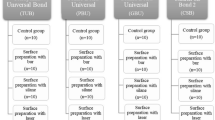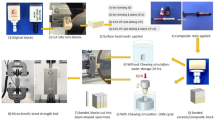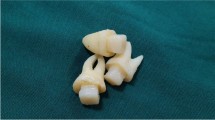Abstract
The objective of this study was to investigate the effect of two different surface treatments (Er:YAG laser and bur) and three different numbers of thermal cycling (no aging, 1,000, 5,000, and 10,000 cycles) on the micro-shear bond strength of repaired composite resin. Ninety-six composite blocks (4 mm × 4 mm × 1 mm) obtained with a micromatrix hybrid composite were prepared. The composite blocks were then randomly divided into four groups (n = 24), according to the thermal cycling procedure: (1) stored in distilled water at 37°C for 24 h (control group), (2) 1,000 cycles, (3) 5,000 cycles, and (4) 10,000 cycles. After aging, the blocks were further subdivided into two subgroups (n = 12), according to surface treatment. Bur and laser-treated composite surfaces were treated with an etch&rinse adhesive system. In addition, a microhybrid composite resin was bonded to the surfaces via polyethylene tubing. Specimens were subjected to micro-shear bond strength test by a universal testing machine with a crosshead speed of 0 and 5 mm/min. The data were analyzed using one-way analysis of variance and Tukey tests (α = 0.05) for micro-shear bond strengths. After conducting a bond strength test, it was found that the laser and bur-treated specimens had similar results. Aging with 10,000 thermocycles significantly affected the repair bond strength of composite resins.


Similar content being viewed by others
References
Magni E, Ferrari M, Papacchini F, Hickel R, Ilie N (2011) Influence of ozone on the composite-to-composite bond. Clin Oral Investig 15(2):249–256
Yaman BC, Efes BG, Dörter C, Gömeç Y, Erdilek D, Yazıcıoğlu O (2011) Microleakage of repaired class V silorane and nano-hybrid composite restorations after preparation with erbium:yttrium-aluminum-garnet laser and diamond bur. Lasers Med Sci 26(2):163–170
Gordan VV (2001) Clinical evaluation of replacement of class V resin based composite restorations. J Dent 29:485–488
Rathke A, Tymina Y, Haller B (2008) Effect of different surface treatments on the composite-composite repair bond strength. Clin Oral Investig 13(3):317–323
Güler AU, Sarikaya IB, Güler E, Yücel A (2009) Effect of filler ratio in adhesive systems on the shear bond strength of resin composite to porcelains. Oper Dent 34(3):299–305
Fawzy AS, El-Askary FS, Amer MA (2008) Effect of surface treatments on the tensile bond strength of repaired water-aged anterior restorative micro-fine hybrid resin composite. J Dent 36(12):969–976
Vankerckhoven H, Lambrechts P, van Beylen M, Davidson CL, Vanherle G (1982) Unreacted methacrylate groups on the surfaces of composite resins. J Dent Res 61:791–795
Swift EJ Jr, LeValley BD, Boyer DB (1992) Evaluation of new methods for composite repair. Dent Mater 8(6):362–365
Ozcan M, Barbosa SH, Melo RM, Galhano GA, Bottino MA (2007) Effect of surface conditioning methods on the microtensile bond strength of resin composite to composite after aging conditions. Dent Mater 23(10):1276–1282
Burnett LH Jr, Shinkai RS, Eduardo CP (2004) Tensile bond strength of a one-bottle adhesive system to indirect composites treated with Er:YAG laser, air abrasion, or fluoridric acid. Photomed Laser Surg 22(4):351–356
Rossato DM, Bandeca MC, Saade EG, Lizarelli RFZ, Bagnato VS, Saad JRC (2009) Influence of Er:YAG laser on surface treatment of aged composite resin to repair restoration. Laser Physics 19(11):2144–2149
de Paula Eduardo C, Bello-Silva MS, Moretto SG, Cesar PF, de Freitas PM (2010) Microtensile bond strength of composite resin to glass-infiltrated alumina composite conditioned with Er,Cr:YSGG laser. Lasers Med Sci. doi:10.1007/s10103-010-0822-9
Kimyai S, Mohammadi N, Navimipour EJ, Rikhtegaran S (2010) Comparison of the effect of three mechanical surface treatments on the repair bond strength of a laboratory composite. Photomed Laser Surg 28(2):25–30
Shawkat ES, Shortall AC, Addison O, Palin WM (2009) Oxygen inhibition and incremental layer bond strengths of resin composites. Dent Mater 25(11):1338–1346
Ghivari S, Chandak M, Manvar N (2010) Role of oxygen inhibited layer on shear bond strength of composites. J Conserv Dent 13(1):39–41
Boyer DB, Chan KC, Torney DL (1978) The strength of multilayer and repaired composite resin. J Prosthet Dent 39:63–67
Craig RG, Powers JM (2002) Restorative Dental Materials, 11th edn. Mosby, USA
Söderholm KJ, Roberts MJ (1991) Variables influencing the repair strength of dental composites. Scand J Dent Res 99:173–180
Rinastiti M, Ozcan M, Siswomihardjo W, Busscher HJ (2010) Effects of surface conditioning on repair bond strengths of non-aged and aged microhybrid, nanohybrid, and nanofilled composite resins. Clin Oral Investig. doi:10.1007/s00784-010-0426-6
Versluis A, Tantbirojn D, Douglas WH (1997) Why do shear bond tests pull out dentin? J Dent Res 76:1298–1307
Della Bona A, Van Noort R (1995) Shear vs. tensile bond strength of resin composite bonded to ceramic. J Dent Res 74:1591–1596
Shimada Y, Senawongse P, Harnirattisai C, Burrow MF, Nakaoki Y, Tagami J (2002) Bond strength of two adhesive systems to primary and permanent enamel. Oper Dent 27(4):403–409
Ishikawa A, Shimada Y, Foxton RM, Tagami J (2007) Micro-tensile and micro-shear bond strengths of current self-etch adhesives to enamel and dentin. Am J Dent 20:161–166
Korkmaz Y, Ozel E, Attar N, Bicer CO, Firatli E (2009) Microleakage and scanning electron microscopy evaluation of all-in-one self-etch adhesives and their respective nanocomposites prepared by erbium:yttrium-aluminum-garnet laser and bur. Lasers Med Sci 25(4):493–502
Hatibovic-Kofman S, Wright GZ, Braverman I (1998) Microleakage of sealants after conventional, bur, and air-abrasion preparation of pits and fissures. Pediatr Dent 20:173–176
Lizarelli RF, Moriyama LT, Bagnato VS (2003) Ablation of composite resins using Er:YAG laser–comparison with enamel and dentin. Lasers Surg Med 33(2):132–139
Brosh T, Pilo R, Bichacho N, Blutstein R (1997) Effect of combinations of surface treatments and bonding agents on the bond strength of repaired composites. J Prosthet Dent 77:122–126
Nilsoon E, Alaeddin S (2000) Factors affecting the shear bond strength of bonded composite inlays. Int J Prosthodont 13:52–58
Bonstein T, Garlapo D, Donarummo J Jr, Bush PJ (2005) Evaluation of varied repair protocols applied to aged composite resin. J Adhes Dent 7(1):41–49
Yesilyurt C, Kusgoz A, Bayram M, Ulker M (2009) Initial repair bond strength of a nano-filled hybrid resin: effect of surface treatments and bonding agents. J Esthet Restor Dent 21(4):251–260
Lucena-Martín C, González-López S, Navajas-Rodríguez de Mondelo JM (2001) The effect of various surface treatments and bonding agents on the repaired strength of heat-treated composites. J Prosthet Dent 86:481–488
Swift EJ Jr, Cloe BC, Boyer DB (1994) Effect of a silane coupling agent on composite repair strengths. Am J Dent 7:200–202
Alexander R, Xie J, Fried D (2002) Selective removal of residual composite from dental enamel surfaces using the third harmonic of a Q-switched Nd:YAG laser. Lasers Surg Med 30:240–245
Lizarelli RFZ, Moriyama LT, Pelino JEP, Bagnato VS (2005) Ablation rate and morphological aspects of composite resins exposed to Er:YAG laser. J Oral Laser App 5(3):151–160
Cavalcanti AN, Pilecki P, Foxton RM, Watson TF, Oliveira MT, Gianinni M, Marchi GM (2009) Evaluation of the surface roughness and morphologic features of Y-TZP ceramics after different surface treatments. Photomed Laser Surg 27(3):473–479
Attin T, Buchalla W, Kielbassa AM, Helwig E (1995) Curing shrinkage and volumetric changes of resin-modified glass ionomer restorative materials. Dent Mater 11:359–362
Suzuki S, Ori T, Saimi Y (2005) Effects of filler composition on flexibility of microfilled resin composite. J Biomed Mater Res B Appl Biomater 74:547–552
Amaral FL, Colucci V, Palma-Dibb RG, Corona SA (2007) Assessment of in vitro methods used to promote adhesive interface degradation: a critical review. J Esthet Restor Dent 19(6):340–353
Xie C, Han Y, Zhao XY, Wang ZY, He HM (2010) Microtensile bond strength of one- and two-step self-etching adhesives on sclerotic dentin: the effects of thermocycling. Oper Dent 35(5):547–555
Nikaido T, Kunzelmann KH, Chen H, Ogata M, Harada N, Yamaguchi S, Cox CF, Hickel R, Tagami J (2002) Evaluation of thermal cycling and mechanical loading on bond strength of a self-etching primer system to dentin. Dent Mater 18(3):269–275
Gale MS, Darvell BW (1999) Thermal cycling procedures for laboratory testing of dental restorations. J Dent 27(2):89–99
Author information
Authors and Affiliations
Corresponding author
Rights and permissions
About this article
Cite this article
Özel Bektas, Ö., Eren, D., Herguner Siso, S. et al. Effect of thermocycling on the bond strength of composite resin to bur and laser treated composite resin. Lasers Med Sci 27, 723–728 (2012). https://doi.org/10.1007/s10103-011-0958-2
Received:
Accepted:
Published:
Issue Date:
DOI: https://doi.org/10.1007/s10103-011-0958-2




